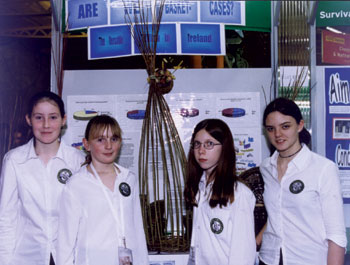| 2003 |

|
YEAR BOOK |
Clifden Community School, Co. Galway
|
Are we basket cases? - the versatile willow of Ireland
|

We fulfilled our aims and objectives but discovered much more in the course of the study. From learning the skill of basket making, we discovered it is not a simple task. There are many different techniques and various weaves involved. Different sized rods are used to make different parts of one basket. Though rewarding and relaxing, it can be tough on your hands. We did a display of our baskets at the RDS and one of the group was continuously weaving baskets as part of our exhibition.
Ireland has a perfect climate for growing willows. They enjoy wet conditions, bogs and marshes. Willows have been grown in other countries as a biomass fuel. Why not in Ireland? In Northern Ireland, experiments have been carried out on this use of the willow. It could also be a means of disposing of our waste sludge and in the treatment of water. The willows are grown to be harvested regularly and burnt in a stove to generate heat and electricity. We are living at a time when our main sources of energy, fossil fuels, are declining rapidly. Fossil fuels also contribute to pollution and acid rain. Humans must find alternatives to fossil fuels on this earth if we are to maintain it for our children.
Growing willow will produce a lot of oxygen. In photosynthesis, they use carbon dioxide gas. While they are growing, they can be fertilised with our waste water, as a source of nutrients. This would help us get rid of our increasing waste liquids. The knowledge we have gained in our research all points towards using the willow to its full potential in this country. Ireland is crying out for eco-friendly solutions to increasing human-caused problems. Could our versatile little willow be a stepping stone to one of those solutions?
Claire Mullen, Eithne Mullen, S�ona de Lappe & Aoife Brady entered their project in the Junior Group Section in the Biological and Ecological Sciences Category at the Esat BT Young Scientist & Technology Exhibition in January 2003. They won a Special Award presented by Comhar - The National Sustainable Development Partnership.
Their teacher was Ms Olivia Staunton.
|
|